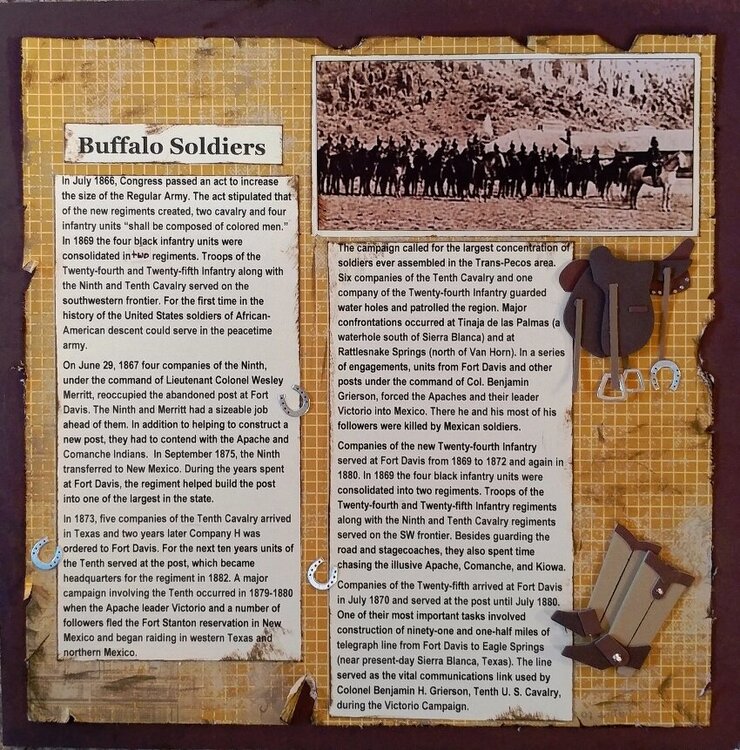
EXTRA 11% OFF Orders $100+ With Code: THANKYOU

 Give a Cheer
Give a Cheer
This page was done to document about the African-American soldiers (or Buffalo soldiers as the Indians called them) that were stationed at Fort Davis. The picture is taken from the Park's website. Journaling from 2 sources. Little off when I reread it but it works.
Journaling: In July 1866, Congress passed an act to increase the size of the Regular Army. The act stipulated that of the new regiments created, two cavalry and four infantry units “shall be composed of colored men.” In 1869 the four black infantry units were consolidated in two regiments. Troops of the Twenty-fourth and Twenty-fifth Infantry along with the Ninth and Tenth Cavalry served on the southwestern frontier. For the first time in the history of the United States soldiers of African-American descent could serve in the peacetime army.
On June 29, 1867 four companies of the Ninth, under the command of Lieutenant Colonel Wesley Merritt, reoccupied the abandoned post at Fort Davis. The Ninth and Merritt had a sizeable job ahead of them. In addition to helping to construct a new post, they had to contend with the Apache and Comanche Indians. In September 1875, the Ninth transferred to New Mexico. During the years spent at Fort Davis, the regiment helped build the post into one of the largest in the state.
In 1873, five companies of the Tenth Cavalry arrived in Texas and two years later Company H was ordered to Fort Davis. For the next ten years units of the Tenth served at the post, which became headquarters for the regiment in 1882. A major campaign involving the Tenth occurred in 1879-1880 when the Apache leader Victorio and a number of followers fled the Fort Stanton reservation in New Mexico and began raiding in western Texas and northern Mexico.
The campaign called for the largest concentration of soldiers ever assembled in the Trans-Pecos area. Six companies of the Tenth Cavalry and one company of the Twenty-fourth Infantry guarded water holes and patrolled the region. Major confrontations occurred at Tinaja de las Palmas (a waterhole south of Sierra Blanca) and at Rattlesnake Springs (north of Van Horn). In a series of engagements, units from Fort Davis and other posts under the command of Col. Benjamin Grierson, forced the Apaches and their leader Victorio into Mexico. There he and his most of his followers were killed by Mexican soldiers.
Companies of the new Twenty-fourth Infantry served at Fort Davis from 1869 to 1872 and again in 1880. In 1869 the four black infantry units were consolidated into two regiments. Troops of the Twenty-fourth and Twenty-fifth Infantry regiments along with the Ninth and Tenth Cavalry regiments served on the SW frontier. Besides guarding the road and stagecoaches, they also spent time chasing the illusive Apache, Comanche, and Kiowa.
Companies of the Twenty-fifth arrived at Fort Davis in July 1870 and served at the post until July 1880. One of their most important tasks involved construction of ninety-one and one-half miles of telegraph line from Fort Davis to Eagle Springs (near present-day Sierra Blanca, Texas). The line served as the vital communications link used by Colonel Benjamin H. Grierson, Tenth U. S. Cavalry, during the Victorio Campaign.
pps: My Minds Eye - Bohemia (brown), Scribble Scrabble (dark yellow), ink - Tim Holtz, stickers - Jolee After I took the picture I realized that a horseshoe was stuck on a strap from the saddle sticker. I took it off and placed it between the 2 large stickers by the 2nd paragraph of the journaling on the right. Used a scissor for distressing.
Thanks for spreading positivity!
March 31, 2021
March 30, 2021
March 30, 2021
March 30, 2021
March 29, 2021
March 29, 2021
March 29, 2021
March 29, 2021
March 29, 2021
March 29, 2021
March 29, 2021
March 29, 2021
March 29, 2021